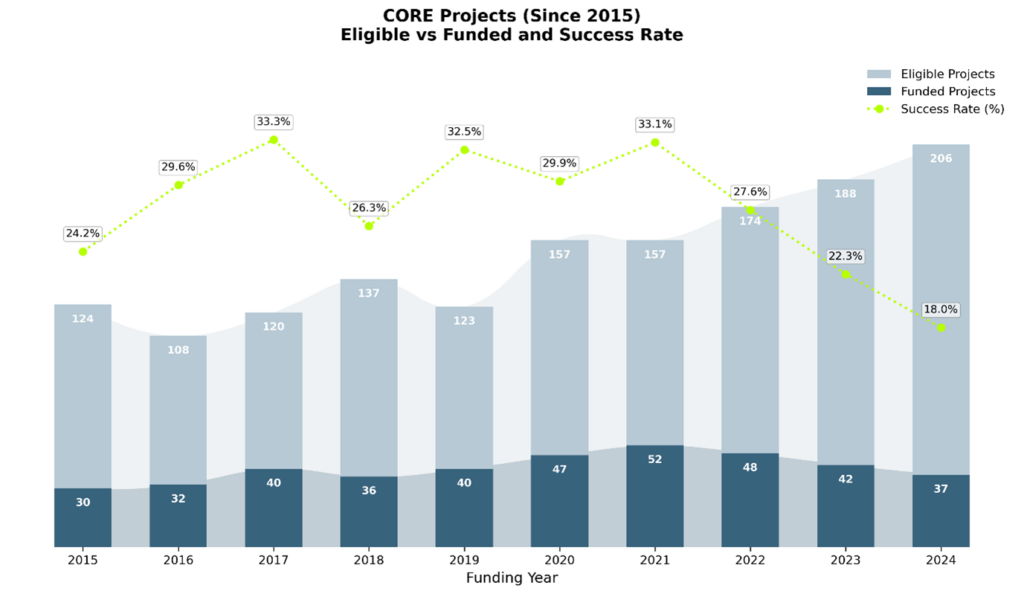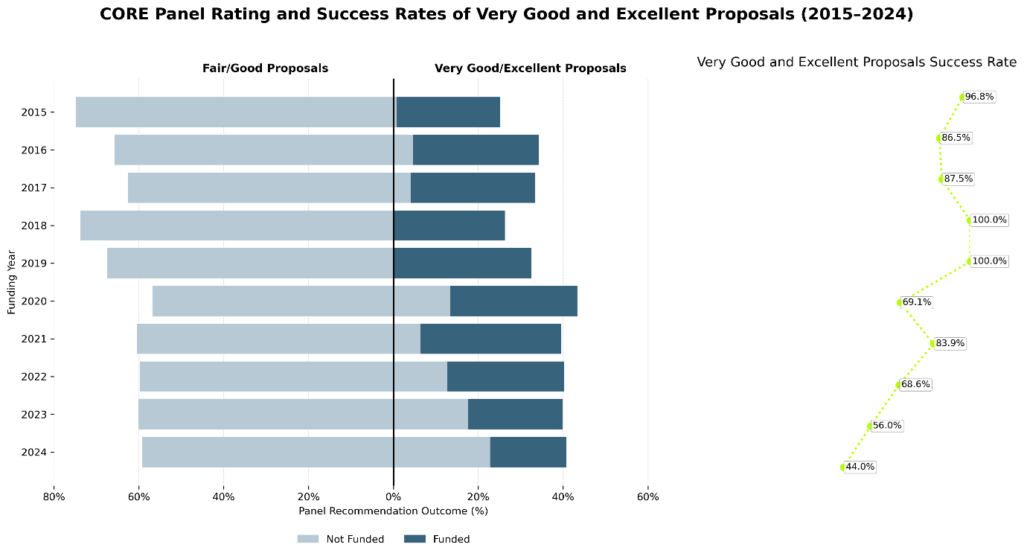BACK TO RESEARCH WITH IMPACT: FNR HIGHLIGHTS
As the 10th April deadline for the 2025 CORE call approaches, we take a moment to reflect on the evolving landscape of FNR’s flagship funding programme that exists since 2008. Over the past decade, the CORE programme has seen a consistent rise in the number of project submissions. While this signals a vibrant and ambitious research community, it also presents growing challenges.

From 2015 to 2024, the number of eligible proposals increased by over 66%, from 124 to more than 200. The overall success rate fluctuated but steadily decreased, from 24% in 2015 to 18% in 2024, with a significant decline occurring over the past four years. The rise in project submissions since 2020 may be partly due to the revised National Research Priorities and increased collaborations with partner agencies, which offer opportunities for a larger research community.
Encouragingly, the number of excellent proposals has grown in parallel with this increase in demand. Over the years, we have observed a steady improvement in the proportion of CORE projects rated “Excellent” and “Very good” by international peer evaluation panels, especially between 2015 and 2020, jumping from 23% up to 40% of the eligible pool. This reflects the increasing scientific quality and competitiveness of Luxembourg’s public research community.

However, this also means that competition is now so strong that even very good proposals are increasingly left unfunded due to resources not growing proportional to demand. Nearly all ‘Excellent” and “Very good” projects were funded in 2015, and 37% of very good proposals could be supported in 2024. Simultaneously, we notice a gradual yet consistent rise in the average budget requested per project. In 2015, the average requested budget was €575k, which has grown to €681k by 2024. This indicates that, on average, a CORE project now costs 18% more than it did in 2015, while the average project duration remains around 36 months. This, combined with the available annual budget envelope, puts pressure on funding decisions.
This trend echoes concerns from peers from other funding agencies, such as SNSF who have described that the “Rising demand for funding is becoming a challenge”. As we continue to support excellence in Luxembourg’s public research system, this situation highlights the importance of continuously reflecting on how our funding instruments can evolve to keep supporting a broad range of excellent proposals in an increasingly competitive environment.
Specifications
- The data used stem from the internal FNR database.
- Funded Projects: Projects with a positive funding decision.
- Eligible Projects: Projects that meet the funding criteria.
- Panel Recommendation: In the CORE peer review process, each project is evaluated by at least three international external reviewers. Following these assessments, the evaluation panels discuss all proposals and establish a final ranking, which forms the basis for funding recommendations. Final funding decisions are made by FNR’s decision-making bodies, considering both the panel’s ranking and the constraints of the annual budget envelope.
- Success Rate: The number of funded projects divided by the number of eligible projects. It reflects the share of proposals that received a grant.
About the series “FNR Funding Data Facts”
FNR Funding Data Facts are bite-sized stories built around our funding data, designed to offer clear and accessible insights into how public research funding is distributed by the FNR.
Each edition focuses on a specific topic — from submission numbers and international collaboration to panel recommendations, diversity, and more. Through simple visuals and concise takeaways, we aim to shed light on how our funding programmes work and how they evolve over time.
Our goal? To foster transparency and support informed dialogue.
This is a living series — we’ll be updating it regularly at key moments, such as the launch or closing of specific calls, programme anniversaries, or in response to questions from researchers or citizens.
Have a question you think we can answer with data?
Reach out to us on data@fnr.lu — and we’ll see if we can provide a visual answer.